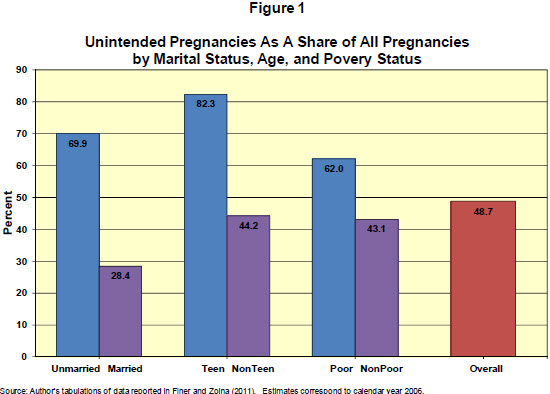Abstract
Unintended pregnancy is a widespread problem with far-reaching implications: almost half of all pregnancies in the United States are unintended, and the women and children involved in these pregnancies are disproportionately likely to experience a range of negative outcomes. I review research on the causes of unintended pregnancy and the impacts of various evidence-based pregnancy prevention policies. I discuss the estimated effects of mass media campaigns discouraging unprotected sex, teen pregnancy prevention programs, and expansions in publicly funded family planning services, and then present new research showing that expansions in these policies would likely lead to reductions in teen and unintended pregnancy, out-of-wedlock childbearing, and child poverty. The research also shows that each dollar spent on these policies would produce taxpayer savings of between two and six dollars. Over the last few years, prudent investments have been made in several proven pregnancy prevention policies. Some of these investments, however, have recently come under attack at the state and federal levels. The findings presented in this brief suggest that policymakers would be wise to expand these programs rather than pare them back.
A Major Societal Challenge
Nearly half of all pregnancies in the United States are unintended, and the parents and children involved in these pregnancies tend to be disadvantaged in a number of ways. For example, Figure 1 shows that unintended pregnancies are disproportionately concentrated among women who are unmarried, teenaged, and poor. Some studies have used sophisticated statistical techniques in an attempt to determine the extent to which pregnancy intentions have a causal effect on maternal and child outcomes. These studies generally suggest that unintended pregnancy and childbearing depress levels of educational attainment and labor force participation among mothers and lead to higher crime rates and poorer academic, economic, and health outcomes among children.

In addition, unintended pregnancy has important implications for public sector balance sheets. For instance, Emily Monea and I estimate that taxpayer spending on Medicaid-subsidized medical care related to unintended pregnancy totals more than $12 billion annually. This figure is substantially more than the federal government spends on the Head Start and Early Head Start programs each year. Unintended pregnancies are also much more likely than intended pregnancies to be terminated. Unintended pregnancies account for more than 90 percent of all abortions—and a substantial majority of Americans of all political stripes support the goal of reducing abortions.
In light of these considerations, policymakers have become increasingly interested in devising strategies for encouraging teens and young adults to take the steps necessary to avoid becoming pregnant until they are prepared to assume the responsibilities of parenthood. This policy brief presents new research showing that several different evidence-based strategies have the potential to reduce unintended pregnancy. The same research also shows that this goal can be attained in a cost-effective way: publicly financed mass media campaigns, comprehensive teen pregnancy prevention programs, and expansions in government subsidized family planning services are estimated to save taxpayers between two and six dollars for every dollar spent on them.
Since President Obama took office, lawmakers have made a number of sensible investments in evidence-based pregnancy prevention strategies. However, a recent wave of activity at the state and federal levels—most notably, Congress’s attempt to defund Planned Parenthood and several states’ efforts to do the same—threaten to reverse much of this progress. The evidence reviewed here suggests that public officials would be wise instead to expand their investments in this area.
What’s Behind the Problem?
The reasons behind the high rate of unintended pregnancy can be organized into three broad categories. First, many young women and men lack sufficient motivation to avoid becoming pregnant until they are ready to do so. This fact is partially the result of changes in cultural norms over time: attitudinal data show that there is now substantially less stigma surrounding premarital sex and out-of-wedlock childbearing than was the case a few decades ago. Motivation to avoid pregnancy is also reduced by the pervasive sense among young women in many low-income communities that there are few attractive alternatives to motherhood available to them. Qualitative studies have found that such women often believe their life prospects to be so limited that they anticipate facing few significant economic or social consequences as a result of becoming pregnant before they are married.
A second factor that contributes to unintended pregnancy is that some individuals who are motivated to avoid pregnancy are handicapped by a limited understanding of how to realize their good intentions. For example, survey data consistently show that teens and young adults are woefully misinformed about how to use various methods of contraception, about how safe and effective those methods are if used correctly, and about the importance of using such methods consistently.
A third contributing factor to the high rate of unintended pregnancy is that the costs of the most effective forms of contraception are sometimes prohibitive and/or access to them is limited. Some highly effective and long-acting reversible contraceptive methods (such as intrauterine devices) are comparatively expensive and can only be used if a young woman has access to a health care provider. Although surveys show that individuals tend not to list limited access or high cost as explanations for their failure to use effective contraceptive methods, I present evidence in the next section that increasing access to subsidized contraception has a notable effect on rates of unintended childbearing.
In sum, the prevalence of unintended pregnancies can be attributed to the fact that many teens and young adults lack the motivation necessary to avoid becoming pregnant; that some individuals are well motivated but are poorly informed about how best to protect themselves from an unplanned pregnancy; and that some of those who are armed with good intentions and the proper information contend with limited access to affordable and effective forms of contraception.
Proven Policy Solutions
Fortunately, public policy has been shown to affect all three of these factors. Regarding the lack of motivation to avoid unintended pregnancy, there is a growing body of evidence suggesting that well-designed mass media campaigns can persuade some young men and women to avoid unprotected sex. Evaluations of these campaigns often compare a treatment city that was exposed to a given campaign with a control city that was not. Most of the campaigns in question encouraged condom use. Taken as a whole, the evaluation literature on these campaigns suggests that they changed the behavior of somewhere between 3 and 6 percent of their target populations. Although this may sound like a small effect, the results reviewed below show that a national media campaign has the potential to produce notable impacts on rates of unintended pregnancy and child poverty in a cost-effective way.
Insufficient knowledge about how to avoid unintended pregnancy is most commonly addressed via pregnancy prevention programs targeted on teens. These programs assume any number of forms: some are classroom based, others incorporate a strong youth development component, and still others rely heavily on parent involvement. However, their common thread is that they all focus at least in part on providing participants with information about how to protect themselves from unplanned pregnancy. The most successful programs tend to emphasize sexual abstinence as the only foolproof option while also educating participants about how to use various methods of contraception. Many of these programs have been evaluated using random assignment, which is the gold standard among the techniques available to policy researchers. Although there is enormous diversity in the findings from these evaluations, some of the best designed interventions produced reductions of 15 percent or more in rates of sexual activity and increases of 25 percent or more in rates of contraceptive use.
Abstinence-only sex education programs are also designed to discourage teens from having risky sex. The bulk of the high-quality research literature on these programs suggests that they have little effect on the behavior of the individuals who participate in them. A partial exception to this rule can be found in a recent study conducted by John Jemmott, a professor at the University of Pennsylvania, and his colleagues. This study—which used random assignment to evaluate an abstinence-only intervention implemented in an unnamed northeastern city—found that the intervention substantially reduced the frequency of sexual initiation among program participants. It should be noted, however, that this program was implemented only for children who were in their preteens or their very early teens. On the whole, there remains little compelling evidence to date that abstinence-only programs can affect the sexual behavior of most teens or of young adults.
Turning to the third reason for the high incidence of unintended pregnancy, there is strong evidence that expansions in access to publicly subsidized family planning services can affect rates of contraceptive use and unintended childbearing. Family planning services (including the provision of contraception) are made available to low-income women via Medicaid. Eligibility for these services has historically been limited to women who are pregnant and to mothers whose incomes place them below a very low threshold. Since the mid-1990s, however, the federal government has granted waivers to about half the states allowing them to serve all income eligible women—regardless of whether they are pregnant or have children—and in most cases allowing states to raise their income eligibility thresholds as well. A recent and well-designed study by Economists Melissa Kearney of the University of Maryland and Phil Levine of Wellesley College used quasi-experimental methods to explore the effect of expanded eligibility for subsidized family planning services in waiver states on women’s contraceptive use. The authors concluded that these expansions resulted in a reduction of about 5 percent in the number of sexually active adult women who fail to use contraception at a given act of intercourse. They also found that the expanded family planning services produced reductions of about 4 percent in the number of births to teens and about 2 percent in the number of births to nonteens.
The bottom line is that the research community has produced solid evidence that public policies can reduce rates of unintended pregnancy. But are they worth the investment of public dollars needed to pay for them?
Policies Are Cost-Effective
The research findings reviewed above were incorporated into a series of benefit-cost simulations of a nationally implemented mass media campaign, a nationwide teen pregnancy prevention program geared towards at-risk youth, and expansions in Medicaid-funded family planning services within states that were not granted family planning waivers by the federal government. These analyses were performed using a cutting-edge simulation model that was developed at the Brookings Institution for the purpose of simulating the impact of policy changes on family formation outcomes. The model is described in greater detail in Box 1.

Table 1 summarizes the key results from these simulations. While the teen pregnancy prevention program is estimated to have the largest effect on the pregnancy rate among teenagers, the expansion in access to subsidized family planning services is estimated to have the largest effect on unintended pregnancy rates overall. The mass media campaign is estimated to have the largest effect on out-of-wedlock childbearing and on the number of children born into poverty. The simulation results indicate that children born into poverty would be reduced by 2.2 percent under the media campaign; by 1.4 percent under the teen pregnancy prevention program; and by 1.8 percent under the Medicaid expansion. These estimates correspond with reductions of 23,000, 15,000, and 19,000 respectively under the three policies.

The bottom portion of the table presents estimates of the cost of each program and of the taxpayer savings that each one would produce. Because of limitations in the relevant data, taxpayer savings are measured only in terms of the amount that would be saved on publicly subsidized medical care for pregnant women and on a variety of means-tested benefits provided to children under the age of five. The prevention of unintended pregnancy would probably also reduce government expenditures on the criminal justice system, on means-tested benefits for older children and adults, and on a range of other spending programs not incorporated into this analysis. Had sufficient data been available to allow for a more complete accounting of the taxpayer savings that would be generated by these policies, my estimates of the monetized benefits of these policies would be even larger.
Even given the relatively conservative approach taken here, the three programs’ estimated benefits substantially exceed their estimated costs. The benefit-cost ratios listed in the final row of the table show that the three interventions would produce public savings of between two and six dollars for each tax dollar spent. Due in large part to the fact that the Medicaid expansion and mass media campaign have lower costs per member of their target populations than does the more intensive teen pregnancy intervention, the benefit-cost ratios for the former two programs are higher than for the latter one. In other simulations whose results are documented in a longer paper but are not shown here, changes were made to some of the key assumptions underlying these analyses in order to test the sensitivity of their results. Under most of these alternative specifications, the core finding persisted that these policies would produce more in taxpayer savings than would be required to fund them.
The key message of these results is that each program would generate a substantial net savings for taxpayers at the same time that it helps to reduce child poverty and avert teen and unintended pregnancies. All three policies are thus a win-win proposition for taxpayers and for the populations they serve.
Charting The Way Forward
Policymakers have begun to make prudent investments in effective strategies for reducing unintended pregnancy. For example, the Patient Protection and Affordable Care Act (ACA) passed in 2010 contains a provision that gives most states the option of expanding eligibility for Medicaid family planning services without having to go through the cumbersome federal waivers process. This provision is relevant for states that do not have family planning waivers and for a subset of waiver states that could implement further expansions of their programs under the new option. It is now up to individual states to determine whether to avail themselves of the option to raise their eligibility thresholds. Since the passage of the ACA, seven states have thus far done so. With many states facing tight budgets and tough fiscal choices, governors and legislatures may be more inclined to reduce expenditures on social programs than to expand them. But the evidence reviewed here suggests that this is precisely the right time for strapped states to implement expansions in their Medicaid family planning services, since such a move would likely generate budgetary savings in short order.
Separate provisions in the ACA also provide $75 million in annual funding for evidence-based interventions to reduce teen pregnancy and restore $50 million in annual funding for abstinenceonly programs. While the latter provision has little evidentiary support, the research discussed in this brief suggests that the former provision is smart public policy. The funding for evidencebased programs in the ACA complements an additional $110 million in discretionary funding for competitive grants to support both the replication of teen pregnancy prevention programs that have been shown to be effective and the implementation and evaluation of new interventions that have yet to be studied carefully. The Obama administration and Congress deserve credit for showing the foresight to allocate resources to these programs, which are rooted in a rich body of evidence demonstrating their efficacy and their cost-effectiveness.
Unfortunately, there have been no major publicly financed media campaigns discouraging unprotected sex in recent years (there is an ongoing federally funded campaign to highlight the prevalence of AIDS, but it does not place great emphasis on the importance of avoiding risky sexual behavior). Public officials should consider funding such an effort, perhaps using the widely hailed anti-smoking Truth Campaign—which was found to have had a substantial effect on smoking behavior—as a model.
The good news, then, is that progress has been made in implementing two of the three costeffective strategies discussed here. The bad news is that this progress has recently been threatened. Over the past year, lawmakers at the federal level and in some states have attempted to eliminate public funding for Planned Parenthood. The leaders of these efforts argue that taxpayer dollars should not be used to subsidize an organization that provides abortions. However, federal funding for abortion is prohibited under nearly all circumstances. The public support that Planned Parenthood receives instead pays for its other activities—most importantly, its contraceptive services. A handful of states have already succeeded in eliminating part or all of their funding for family planning services. The irony is that these efforts will likely lead to increases in the number of unintended pregnancies and therefore in the number of abortions.
In addition, five states have thus far declined to accept federal funding for evidence-based teen pregnancy prevention programs. Accepting and spending these funds would not impose any costs on states. Indeed, for reasons documented in this brief, these funds would likely generate taxpayer savings at both the federal and state levels even as they reduce teen pregnancy rates.
Overall, then, policymakers deserve a mixed report card. The relevant evidence suggests that state and federal lawmakers would be wise to maintain or even increase their investments in proven pregnancy prevention strategies rather than reduce their efforts in this area. One hopes that the strength of that evidence will ultimately carry the day.
Conclusion
The research reviewed in this brief shows that evidence-based pregnancy prevention interventions are public policy trifectas: they generate taxpayer savings, they improve the lives of children and families, and they reduce the incidence of abortion. These cost saving policies are particularly well suited to the current fiscal climate, in which state lawmakers are struggling to balance their budgets and the federal government is grappling with a yawning debt that is projected to increase in the years to come.
Placing a greater focus on these policies also has the potential to steer the public debate in a more productive direction. Much attention and energy has been devoted over the past decade to promoting marriage as a strategy for reducing the number of children growing up in single-parent families. However, marriage promotion programs have a mixed record at best—only one locally implemented program has thus far been found by a rigorous evaluation to have notable effects— and they are still in the research and development phase as a result. On the other hand, there is a wealth of evidence to suggest that meaningful reductions in single parenthood can be achieved via expansions in policies that curb unintended and out-of-wedlock childbearing.
In summary, the strategies reviewed in this brief—mass media campaigns discouraging unprotected sex, evidence-based teen pregnancy prevention programs, and expansions in publicly subsidized family planning services—merit broad support among public officials at all levels of government. In light of the prevalence of unintended pregnancy and the personal and societal costs that such pregnancies pose, policymakers would do well to invest further in these strategies.
The Brookings Institution is committed to quality, independence, and impact.
We are supported by a diverse array of funders. In line with our values and policies, each Brookings publication represents the sole views of its author(s).





